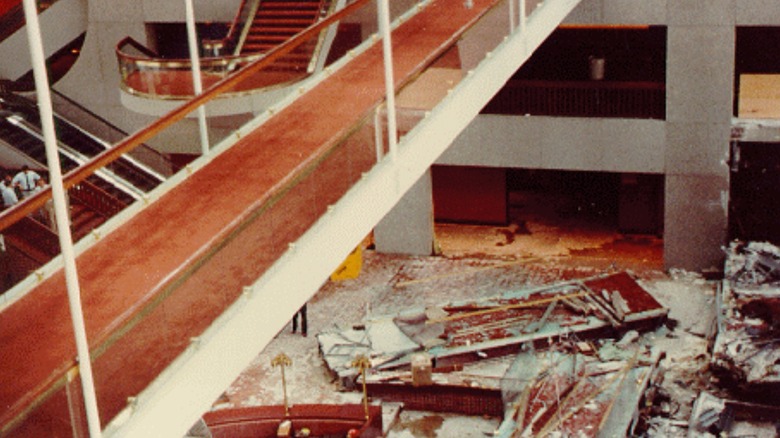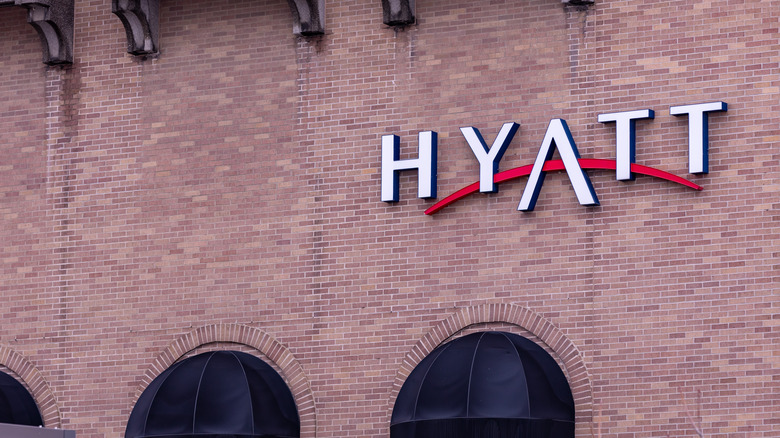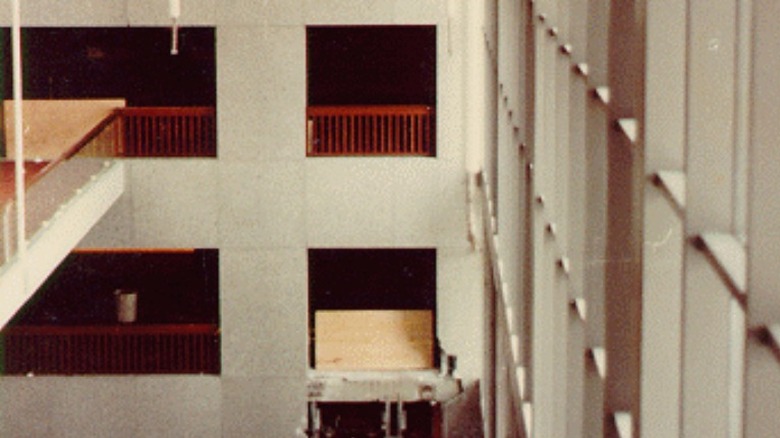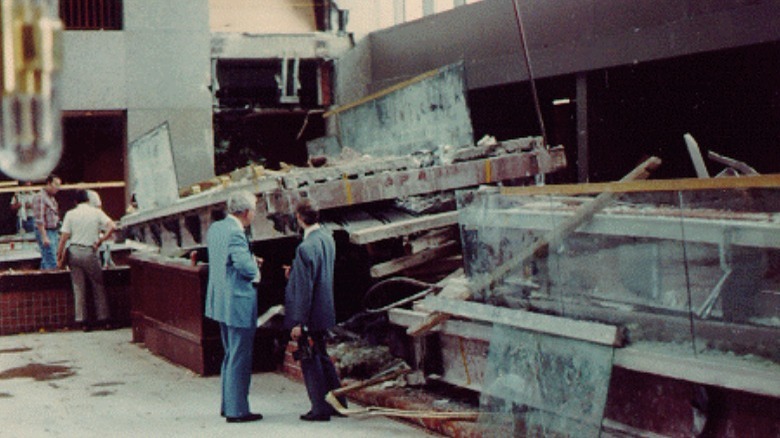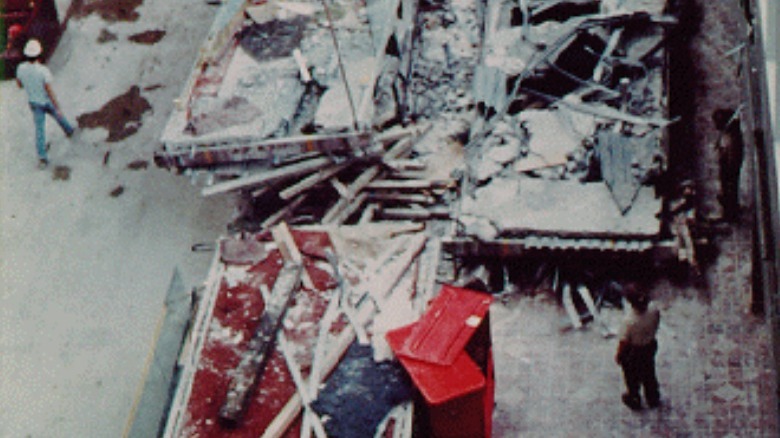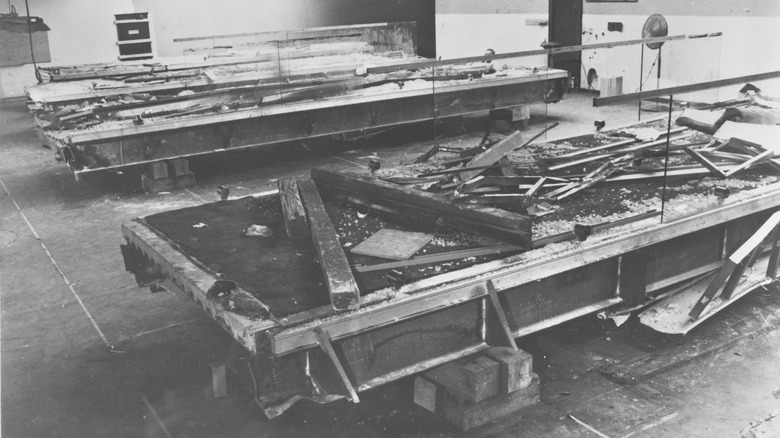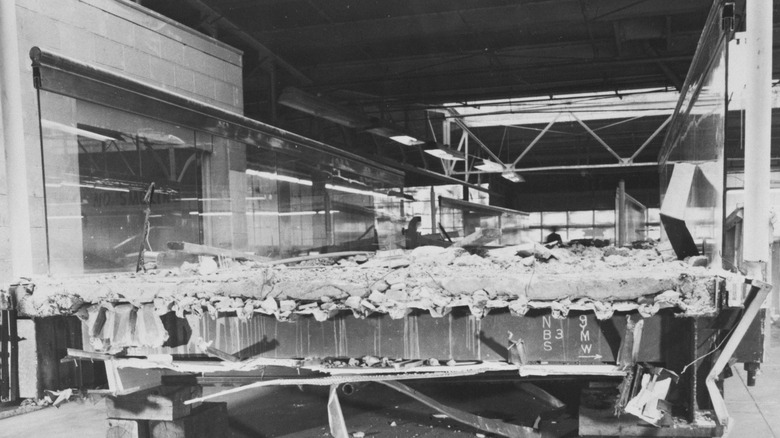Tragic Details About The Deadly Hyatt Regency Walkway Collapse
Since two walkways at the Hyatt Regency Hotel collapsed in Kansas City, Missouri, in 1981, the United States has never experienced a worse accidental collapse. Claiming over 100 lives, the disaster ended up setting a standard for building inspections by third-party engineers in order to ensure that such a tragedy was never repeated.
The response to tragedies like this also changed when it came to the mental health of the victims and first responders. Psychotherapists volunteered to help people within two days of the collapse and mental health centers provided group therapy sessions for 12 weeks to anyone who needed it. "Instead of waiting for the emotional fallout to occur and then trying to pick up the pieces, we took a preventive approach," according to Richard Gist, director of the Kansas City Association for Mental Health.
Unfortunately, a preventative approach should also have been taken into account when constructing the hotel. Numerous incidents of negligence and cost-cutting measure — like the hotel owner Crown Center Redevelopment Co.'s repeated refusal to provide on-site inspections due to the cost – resulted in an entirely preventable tragedy. These are some tragic details about the deadly Hyatt Regency walkway collapse.
Collapse during construction
A little over a year before the walkway disaster, the Hyatt Regency Hotel in Kansas City, Missouri, experienced its first collapse while the hotel was still under construction. On October 14, 1979, a large part of the atrium roof collapsed due to a failure of the roof beam connection and came crashing down onto the construction site (per the Online Ethics Center for Engineering and Science).
No one was injured when almost 3000 square feet of atrium roof collapsed, but the construction site continued to be dangerous. UPI reports that while U.S. Occupational Safety and Health Administration (OSHA) officials only found out about the collapse when they came to the construction site to investigate an unrelated accident that killed a construction worker, they were still quite concerned about the roof collapse. OSHA regional administrator Vernon Strahm even noted that there "must be some structural or architectural failure when something like that happens," per "Skywalks" by R. Eli Paul.
Although the general contractor, Eldridge and Son Construction Co., was fined almost $6,000 for safety violations, they were ultimately cleared and allowed to continue work. And unfortunately, because the OSHA investigation was only concerned with the fatal accident, there was little attention paid to the walkways that later became a death trap, according to the U.S. Department of Commerce's investigation of the Kansas City Hyatt Regency walkways collapse.
Bad designs all the way down
The designs for the suspended walkways, also known as "sky bridges," were flawed from the start. Then, not only were the revised plans also flawed, but the way the design changes were executed and communicated ultimately led to the disaster.
Originally, the plan for suspended walkways through the atrium included six steel hanger rods securing the second-floor walkway to the ceiling. However, the steel subcontractor Havens Steel Company decided that the screw-threaded rods needed to secure the second-floor walkway to the ceiling were too expensive, as well as a potential hazard, so the plans were changed, according to "Ethical Issues from the Kansas City Hyatt Hotel Collapse," by J. Paul Guyer. However, even the original design of the walkway wasn't structurally sound, notes the Online Ethics Center for Engineering and Science.
The design for the walkways was altered so that the second-floor walkway was secured to the fourth-floor walkway rather than the ceiling using two sets of tie rods. As a result, they "doubled the load on that connection, which was ultimately a fatal design change," said architect Bill Quatman, per CNN. To add insult to injury, Havens Steel Company informed the structural engineer of the design change during a telephone call, without even looking at a blueprint together to double-check their math. If someone had just checked it, they would've realized it couldn't work. "Any first-year engineering student could figure it out," said Hyatt engineer Jack Gillum, per The Kansas City Star.
A double collapse
The walkway collapse at the Hyatt Regency Hotel tragically involved two of the walkways that went through the atrium. The atrium featured three walkways overall, which were suspended on the second floor, the third floor, and the fourth floor. While the second-floor walkway was suspended from the fourth-floor walkway, which was then suspended from the roof, the third-floor walkway was suspended from the roof on its own. This independent suspension is what kept the third-floor walkway from joining the catastrophe below.
On July 17, 1981, with a tea dance underway, over 1,600 people were at the Hyatt Regency Hotel. Less than 100 people were watching and dancing on the walkways, but with everyone dancing, the second- and fourth-floor walkways started to sway, according to NPR. KSHB reports that around 7 p.m., people heard a cracking sound as the fourth-floor walkway broke apart, crashing onto the second-floor walkway on its way down. The two walkways collapsing on top of one another doubled the amount of rubble that dozens of people suddenly found themselves trapped beneath.
Loss of limb
The site of the collapse was a devastating scene. In "Everyday Crisis Management" by Mark L. Friedman, Kansas City emergency medical director Joseph Waeckerle describes it as "like a war. There was a lot of screaming. Power lines had broken and were swinging above the lobby, arcing electricity." The collapse was so bad that some people had their limbs torn off as a result.
There was so much rubble and heavy debris due to the double walkway collapse that rescue workers struggled to get people out, even as they used cranes and jackhammers to move the debris. In order to free people from under the collapsed rubble, some people had to have their limbs amputated. The Associated Press reported that one person had their leg amputated with a power saw. With so many people — both dead and alive — trapped together amongst the rubble, rescue teams were also forced to dismember bodies in some instances in order to reach those who were still alive, according to The Structural Engineer.
The fact that rescue workers had to resort to amputating limbs in order to free people from the debris shows how serious the situation was. As Nikolaj Wolfson writes in International Orthopaedics, "the priority is saving life over limb ... [but amputation] is also recommended as a last resort when necessary to facilitate extraction of victims with limbs trapped under the rubble."
The danger of drowning
Lying under heavy pounds of rubble and the threat of crush syndrome weren't the only things collapse victims had to fear. When the walkways collapsed, the sprinkler systems on the roof were damaged as well. As a result, the damaged sprinklers continually sprayed water onto the trapped people. As the water level rose, helped by damaged pipes, there was a real possible threat that those who were still trapped and unable to move might drown before they were rescued. According to Interesting Engineering, it wasn't possible to turn off the sprinkler system because it wasn't connected to the city water supply.
Kansas City emergency medical director Joseph Waeckerle, who was part of the rescue efforts, recalled how "there were several inches of water on the floor. In it was floating feces and human body parts. You just had to ignore all of it and focus on what you were doing," per "Everyday Crisis Management" by Mark L. Friedman.
Ultimately, a bulldozer was brought in to break open the hotel's front doors to let all the water out of the atrium before it completely flooded.
14 hours of rescue
In total, it took rescue workers 14 hours to pull survivors from the rubble. According to Interesting Engineering, there was up to 60 tons of rubble between the rescue team and survivors. Some pieces of concrete were so heavy that manpower alone wasn't enough, and cranes were brought in to lift pieces away while jackhammers and concrete saws were used to break pieces down into more manageable sizes. According to the U.S. Department of Commerce's investigation of the Kansas City Hyatt Regency walkways collapse, the last survivor was pulled out of the rubble at 4:30 a.m. the following day.
During the rescue operation, rescue workers were forced to perform triage, a patient assessment practice that had become the standard for emergency medical services in the United States just a few years earlier. During triage, people are divided into three categories: those who will likely live regardless of medical intervention, those who will likely die regardless of medical intervention, and those who may live if they're given medical care in time.
Over the course of the 14-hour rescue operation, the rescue workers pulled 29 people out of the debris alive. More than 200 other people were injured during the collapse itself.
Deadliest accidental collapse in U.S. history
In total, 114 people were killed when the two walkways collapsed in the Hyatt Regency in 1981. Among them were teachers and military veterans. The Kansas City Star reports that the youngest victim was only 11 years old.
The Hyatt Regency walkway collapse became the deadliest accidental building collapse in United States history. The American Society of Civil Engineers called it "one of the most devastating structural failures in U.S. history in terms of lives lost." Until the collapse of the World Trade Center in New York City, which claimed over 2,000 lives, it was the deadliest building collapse of any kind in the United States.
The Hyatt Regency collapse has been frequently compared to the Surfside condominium collapse in June 2021, which killed almost as many people, reported NPR. Other parallels included the fact that both buildings showed signs of structural damage well before the fatal collapses, reports The Kansas Star.
Psychological trauma
There were approximately 1,500 people in the lobby when the walkways came crashing down. Although the majority of them survived, the trauma of the event continued to psychologically affect the survivors. According to The New York Times, many who witnessed the horrific collapse scene subsequently experienced insomnia, sensitivity to smells and noises, and loss of appetite. Some also became prone to anger and started lashing out. The psychological effects weren't limited to the survivors of the collapse. Some rescue workers and emergency technicians also suffered from nightmares for days after the collapse.
Many were also plagued with survivor's guilt. John Davis — who brought his wife Judy and their two friends, Larry and Suzanne Watson, to the tea dance — ended up being the only one to survive the collapse. This was made more difficult to bear due to the fact that John Davis had been the one to suggest going to the tea dance.
A year after the collapse, Dr. Charles Wilkinson interviewed 103 survivors to study the long-term emotional effects of the collapse. In his study, Wilkinson found that almost all of the survivors interviewed continued to experience psychological effects, including nightmares, anxiety about overhead objects and balconies, and sensitivity to noises, per The New York Times. Some survivors even continued to drive out of their way to avoid seeing the Hyatt Regency more than a year after the collapse.
Denying all liability
After the accident, everyone involved with the construction of the Hyatt Regency denied any legal liability having to do with the collapse. This was true of everyone from the architects, engineers, and construction company, all the way up to hotel owner Crown Center Corporation and its parent company Hallmark.
Investigation of the collapse took months, but within a year, there were almost 350 lawsuits filed against those involved in the construction of Hyatt Regency that totaled over $3 billion, according to The New York Times. Some individual suits amounted to over $200 million.
Ultimately, at least 285 lawsuits ended up being settled for nearly $100 million. In a class action lawsuit, a $10 million settlement was approved by a federal district judge in January 1983. In the settlement, Hallmark Cards also agreed to pay $6.5 million to charities like Heart of America United Way and the Children's Mercy Hospital over the course of four years.
Popular Mechanics writes that the largest individual settlement that was paid out was $12 million to Sally Firestone, who had been standing on the second-floor walkway and lost the use of her arms and legs due to the collapse. But throughout all of the settlements, not a single defendant acknowledged any responsibility or fault. National Bureau of Standards investigator Edward Pfrang later stated that "you had a process of everyone wanting to walk away from responsibility" per The Kansas City Star.
Gross negligence overall
The investigation into the cause of the collapse took almost seven months. The United States Department of Commerce released its full report on the incident in February 1982, finding that the steel rods were unable to bear the weight required of them. This meant that the issue was structural rather than architectural. Structural engineer Wayne G. Lischka was also hired by The Kansas City Star to conduct an investigation into the collapse and he similarly attributed the collapse to the steel rods.
At this point, it became a case of passing the blame back and forth. Structural engineers Jack Gillum and Daniel Duncan of Gillum-Colaco, Inc. claimed that Havens Steel Company, which fabricated the steel rods, should've tested to make sure that the steel would hold in the walkways. The steel company claimed that this was the responsibility of structural engineers. But the issue wasn't just the steel rods. Interesting Engineering writes that there were multiple incidents of negligence that made the collapse tragically avoidable.
In November 1984, Duncan, Gillum, and Gillum-Colaco, Inc. were found guilty of gross negligence, among other charges, after being charged by the Missouri Board of Architects, Professional Engineers, and Land Surveyors. According to Popular Mechanics, both Gillum and Duncan lost their professional license to practice in Missouri as a result of gross negligence. They were the very first engineers this had ever happened to in the United States.
Not the first collapse
Tragically, the Hyatt Regency walkway collapse wasn't the first building collapse the United States had experienced that year. Earlier in 1981, on March 27, a five-story residential development collapsed in Cocoa Beach, Florida, while under construction, killing 11 workers and injuring 23 others. This collapse was also ultimately found to be due to structural engineering and construction issues, according to the University of Alabama.
There had also been numerous collapses in previous years, leading The Kansas City Star to remark after the Hyatt Regency collapse that "notable structures around the country were failing at an alarming rate." These disasters were due in part to the fact that high-interest rates and inflation were causing builders to cut costs and focus on the quantity of projects rather than the quality.
These reasons may also have contributed to the collapse of the Hartford Civic Center Arena, now known as the XL Center, in 1978. According to the University of North Carolina Charlotte, the roof of the arena collapsed just six hours after the area had been filled with 5,000 people. Luckily, no one was in the building when it collapsed at 4:15 a.m. But like the Hyatt Regency walkway collapse, the Hartford Civic Center Arena collapse was a preventable accident — from the many deflections during construction to the construction manager's decision not to hire a structural engineer because it was a waste of money.
[Featured image by Doug Kerr via Wikimedia Commons | Cropped and scaled | CC BY-SA 2.0]
